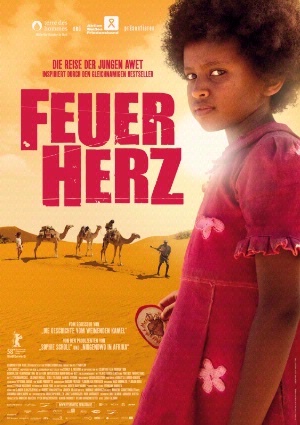
FEUER HERZ (HEART OF FIRE)
Germany, 2008, 92 minutes, Colour.
Letekidan Micael, Salomie Micael, Seble Tilahun, Daniel Seyoun.
Directed by Luigi Falorni.
This is an emotional film about war in Eritrea. It is based on a memoir by Senait G. Menari. On its publication, controversy arose, questioning its veracity that the author spent time as a child soldier.
At the launch of the film in competition in Berlin, the Press Conference with the makers offered a definition of a child soldier, especially in view of the Eritrean government’s denials and literature distributed outside the screening. The definition is that any child under the age of 18 involved in any war effort (not just the bearing of arms) is a child soldier. The filmmakers also wanted to stress the point that in Eritrea, unlike in Uganda and Sierra Leone, children were not forced to take up arms but that many children did so voluntarily and became involved in war.
The makers also made another point, that the film was ‘inspired’ by the book rather than being a factual version and that they had called the little girl Awet rather than the name of the author.
This said, the film is a vivid picture of Eritrea, beginning peacefully at an Italian school in Asmara, then moving to the countryside and villages, then to camps and conflicts between the opposing groups of liberators from Ethiopia.
One of the man reasons for the impact of the film is the screen presence and performance of Letekidan Micael as Awet. She is quite a dynamic actress. As a schoolgirl in Asmara, she is intelligent and questioning, one of her key ideas being that Jesus was wrong about turning the other cheek. She shows how it is physically impossible. However, a local sister explains that it would be a backhanded slap and that this was a symbol of master-slave striking and that turning the other cheek is a defiance and a symbol that there should be no slaves.
Awet has many opportunities to test this when her sister takes her from school to go back to the family village to their father. Later she goes to a military camp. In each plays she readies her cheek for the second strike.
The film shows rebels, the children training with both chores and gun drills, raids – and deaths. It makes a plea against war as the children try to flee the military action and go to Sudan.
The title refers to Awet’s strong spirit. However, a symbol is also offered: a cloth picture of the heart of Jesus (and we also see a picture of the Sacred Heart in close-up) with Mary on the reverse side. Awet treasures it and finally offers it to the nomad leader as a gift for taking the group to freedom.
The film was directed by Luigi Forlani who co-directed The Story of the Weeping Camel.
1.The impact of the film, the target audience, negative critical reaction? The criticisms by the Eritrean government?
2.The controversies concerning the book, the adaptation? The use of the character? Child soldiers, Eritrean denial that there were child soldiers? The definition of the child soldier, the conditions, aged under eighteen, any part in military action? Coerced or free? The effect on the children? The evidence available on Eritrea?
3.The filming in Kenya, the Eritrean cast, the local language?
4.The introduction concerning the clashes? 1961, the relationship with Ethiopia, the clashes between the two sides in Eritrea? The Eritrean Liberation Front?
5.The introduction to Asmara, peace, the Italian heritage, the school, the nuns, the children, mixed race and mixed class? The Eritrean sister? Awet and the bond with her?
6.The classes, the Catholic doctrine, the heart of Jesus, the picture of the Sacred Heart, the cloth picture of the heart with Mary on the other side, Awet treasuring it?
7.Jesus and the teaching of turning the other cheek, the teacher’s interpretation, Awet disagreeing, saying that there could only be a smack on the other cheek? The Eritrean sister and her explanation about slavery, defiance? Not being a slave?
8.Turning the other cheek as a theme, the puzzle, her father, the trainers, the soldiers? The significance? Awet and her stances?
9.Awet called away, her sister coming for her, travelling, no contact with the family? The arrival, the father, the poverty, being cramped for sleeping space, the one dress, collecting the water? Defiant and critical of her father? His slapping her and her standing defiant with the other cheek?
10.Her father, his drinking, self-proclaimed hero, the bar injuries, his friends in the bar? His saving face?
11.Awet, her character, strong personality, intelligent? Going to the camp? Life, drills, work, training, the guns? Her emptying the bullets and being reprimanded, having to hold up the gun for a long time?
12.The attack, the shooting of the rebels in the back?
13.Mica’al, talking with him, friendship, his not being good at arms, military matters, his wanting to leave, his being killed in the attack?
14.The attack, the bullets, the boy shot in the leg? His anger – but willing to leave?
15.The trainer, her strength, Awet imitating her hair, the tougher young woman, the decisions, the role of women in the fighting? The fierce fighter, her clashes with Awet? The men in the group?
16.The decision to get away, going through the desert, the storm, the nomads, giving the cloth with the Heart of Fire, a new life in Sudan?
17.Awet and her own heart of fire, the cloth symbol, the Sacred Heart, Awet as a Christ figure and the use of the heart symbolism?